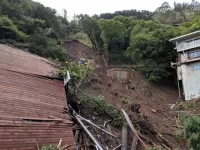(Press-News.org) Recreational drinking, smoking, and drug use is linked to premature heart disease in young people, particularly younger women, finds research published online in the journal Heart.
Those who regularly use 4 or more substances are 9 times as likely to be affected, the findings indicate.
The numbers of new cases of heart disease (atherosclerotic cardiovascular disease) have been increasing in young adults, but the potential role of recreational substance use isn't entirely clear.
To probe this further, the researchers explored whether the recreational use of tobacco, cannabis, alcohol, and illicit drugs, such as amphetamine and cocaine, might be linked to prematurely and extremely prematurely furred up arteries.
They drew on information supplied to the 2014-2015 nationwide Veterans Affairs Healthcare database and the Veterans with premaTure AtheroscLerosis (VITAL) registry.
Extremely premature heart disease was defined as an 'event', such as a heart attack, angina, or stroke before the age of 40, while premature heart disease was defined as an event before the age of 55 in men and before the age of 65 in women.
In all, there were 135,703 people with premature heart disease and 7716 with extremely premature heart disease. They were compared with 1,112, 45 patients who didn't have premature heart disease.
Recreational use of any substance was independently associated with a higher likelihood of premature and extremely premature heart disease.
Patients with premature heart disease were more likely to smoke (63% vs 41%), drink (32% vs 15%), and to use cocaine (13% vs 2.5%), amphetamines (3% vs 0.5%), and cannabis (12.5% vs 3%).
After accounting for potentially influential factors, such as high blood pressure, diabetes, and high cholesterol, those who smoked tobacco were nearly twice as likely to have premature heart disease while those who drank recreationally were 50% more likely to do so.
Cocaine users were almost 2.5 times as likely to have premature heart disease, while those who used amphetamines were nearly 3 times as likely to do so. Cannabis users were more than 2.5 times as likely to have premature heart disease while those using other drugs were around 2.5 times as likely to do so.
The higher the number of substances used recreationally, the greater was the risk of premature heart disease, ranging from a doubling in risk with the use of 1 substance to a 9-fold heightened risk for those using 4 or more.
Similar trends were observed among those who had extremely premature heart disease, with recreational substance use associated with 1.5 to 3 times higher odds of heart disease.
The associations were even stronger among women with premature and extremely premature heart disease than among similarly affected men.
This is an observational study, and as such can't establish causality. And the researchers acknowledge that they were unable to gather information on other potentially influential factors, such as the dose and duration of recreational substance use.
In a linked editorial, Dr Anthony Wayne Orr of LSU Health Shreveport, Louisiana, points out that use of cocaine and methamphetamine have been associated with faster cell ageing and neurocognitive decline, with higher than average loss of grey matter.
And epidemiological studies suggest that 1 in 5 young adults misuse several substances and that these 'polysubstance users' often start using at younger ages, and so have worse health over the long term, he says.
The growing body of published research on these issues "suggests the need for a nationwide education campaign on the potential long-term damage being done to the cardiovascular system in patients with substance use disorders," he argues.
These people need to be aware of the long term consequences for their health beyond the risk of an overdose, while doctors should screen patients with a history of substance misuse, he says.
"We are only young once, and we should do everything in our power to maintain that state as long as we can," he concludes.
INFORMATION:
Externally peer reviewed? Yes
Evidence type: Observational; Opinion (editorial)
Subjects: People
Ageism, sexism, and Western ideals of the nuclear family have excluded grandmothers from national and international policy initiatives to save newborn lives in the Global South, suggests an analysis published in the online journal BMJ Global Health.
This is despite published research indicating that they are a valuable and influential resource for children's health and survival in many cultures, the study author points out.
Around three out of 4 newborn deaths in the Global South occur in the first week of life--40% of them on the first day, and most of them at home.
But ...
Below please find summaries of new articles that will be published in the next issue of Annals of Internal Medicine. The summaries are not intended to substitute for the full articles as a source of information. This information is under strict embargo and by taking it into possession, media representatives are committing to the terms of the embargo not only on their own behalf, but also on behalf of the organization they represent.
1. Zika vaccine candidate shows promise in phase I trial
Abstract: https://www.acpjournals.org/doi/10.7326/M20-5306
Editorial: https://www.acpjournals.org/doi/10.7326/M21-0397
URL goes live when the embargo lifts
The Zika virus candidate, Ad26.ZIKV.001, a replication-incompetent human adenovirus serotype 26 (ad26) vector showed ...
A new paper refines estimates of when herbivorous dinosaurs must have traversed North America on a northerly trek to reach Greenland, and points out an intriguing climatic phenomenon that may have helped them along the journey.
The study, published today in Proceedings of the National Academy of Sciences, is authored by Dennis Kent, adjunct research scientist at Columbia University's Lamont-Doherty Earth Observatory, and Lars Clemmensen from the University of Copenhagen.
Previous estimates suggested that sauropodomorphs -- a group of long-necked, herbivorous dinosaurs that eventually included Brontosaurus and Brachiosaurus ...
Experts have devised a novel approach to selecting photos for police lineups that helps witnesses identify culprits more reliably.
In a paper published by the Proceedings of the National Academy of Sciences, researchers - from the University of California San Diego and Duke University in the United States and the University of Birmingham in the U.K. - show for the first time that selecting fillers who match a basic description of the suspect but whose faces are less similar, rather than more, leads to better outcomes than traditional approaches in the field.
The counterintuitive technique improves eyewitness performance by about 10 percent.
"In ...
CAMBRIDGE, MA -- MIT researchers have invented a new type of amputation surgery that can help amputees to better control their residual muscles and sense where their "phantom limb" is in space. This restored sense of proprioception should translate to better control of prosthetic limbs, as well as a reduction of limb pain, the researchers say.
In most amputations, muscle pairs that control the affected joints, such as elbows or ankles, are severed. However, the MIT team has found that reconnecting these muscle pairs, allowing them to retain their normal push-pull ...
The threat of landslides is again in the news as torrential winter storms in California threaten to undermine fire-scarred hillsides and bring deadly debris flows crashing into homes and inundating roads.
But it doesn't take wildfires to reveal the landslide danger, University of California, Berkeley, researchers say. Aerial surveys using airborne laser mapping -- LiDAR (light detection and ranging) -- can provide very detailed information on the topography and vegetation that allow scientists to identify which landslide-prone areas could give way during an expected rainstorm. This is especially ...
More than one-third of the Corn Belt in the Midwest - nearly 100 million acres - has completely lost its carbon-rich topsoil, according to University of Massachusetts Amherst research that indicates the U.S. Department of Agricultural has significantly underestimated the true magnitude of farmland erosion.
In a paper published in the Proceedings of the National Academy of Sciences, researchers led by UMass Amherst graduate student Evan Thaler, along with professors Isaac Larsen and Qian Yu in the department of geosciences, developed a method using satellite ...
The links between cardiovascular disease and cognitive impairment begin years before the appearance of the first clinical symptoms of either condition. In a study carried out at the Centro Nacional de Investigaciones Cardiovasculares (CNIC) in partnership with Santander Bank and neuroimaging experts at the Barcelonaβeta Brain Research Center (BBRC, the research center of the Fundación Pasqual Maragall), the investigators have identified a link between brain metabolism, cardiovascular risk, and atherosclerosis during middle age, years before the first appearance of symptoms.
The report, published in the Journal of the American College of Cardiology (JACC), ...
Employing cardiovascular disease prevention strategies in mid-life may delay or stop the brain alterations that can lead to dementia later in life, according to a study in the Journal of the American College of Cardiology.
Atherosclerosis, or buildup of fats, cholesterol and other substances in and on artery walls, is the underlying cause of most cardiovascular diseases, which is the leading cause of death around the world. Dementia is also among the top causes of death and disability around the world, with 50 million people currently living with dementia. ...
In a new study out of University of California San Diego School of Medicine, researchers found a drug used for heart failure improves symptoms associated with postural orthostatic tachycardia syndrome, otherwise known as POTS. This complex, debilitating disorder affects the body's autonomic nervous system, causing a high heart rate, usually when standing.
Writing in the February 15, 2021 online issue of the Journal of the American College of Cardiology, study authors investigated the drug ivabradine and its effects on heart rate, quality of life and plasma norepinephrine levels in persons living with POTS. Norepinephrine is a stress hormone and neurotransmitter. In blood plasma, it is used as a measure of sympathetic nervous system activity. Trial participants experienced a reduction in ...



